- Peperomia Serpens: How Easy It Is To Care For It? - September 24, 2021
- Best Indoor Fiberglass Planters Guide: Our Top Picks - September 6, 2021
- Peperomia Polybotrya: Is It Easy To Keep This Plant Alive? - August 31, 2021
For those of us who like to grow our plant collection, we often have problems remembering how much we should water each plant. We might have a difficult time remembering which ones like direct sunlight and which ones like full shade. And who here has accidentally killed a plant for giving it the wrong care?
One way to have an easier time with a growing plant collection is to grow the same kinds of plants having the same care needs. For instance, having a succulent collection will ensure that you don’t have to remember the different watering, light, feeding, and soil requirements for each plant you have.
And if you want leafy plants, you can’t go wrong with peperomias.
Introducing Peperomia Varieties
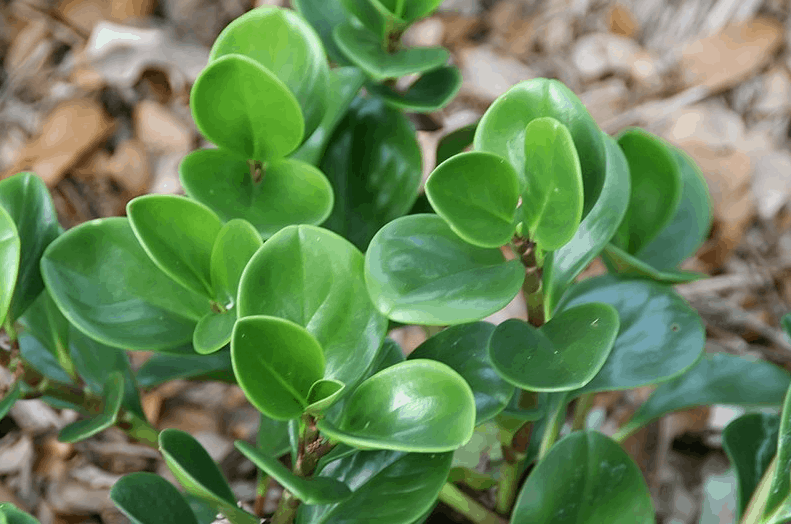
Peperomia is also called the radiator plant. There are at least 1,500 species of this plant that has been recognized.
These are tropical and subtropical perennials. Most of them are epiphytes that grow on rotten or dead wood. Different species and forms of this genus can have various looks, but for the most part, peperomias sport fat and thick stems with fleshy leaves.
But some peperomias have thread-like stems, as well as leaves that are shaped like a lance or a heart. The leaves can be stripped, marbled, entirely green, or have pale green borders. Some varieties have what is called an epidermal window. These translucent parts of the peperomia’s leaves allow more light in and more photosynthesis to happen. These tissues can also sometimes store water.
These plants have brown to yellow flowers that are conical in form. Peperomia is native to Central America and South Africa, with some varieties coming from Africa. These plants usually grow up to 12 inches (30 centimeters) high, making them dwarves compared to other species.
Peperomia Varieties
When you say varieties of peperomia, this genus doesn’t disappoint. You can have a house full of peperomias, and there’s a chance that people may think that they don’t all come from the same family. The differences in looks among these plants are astounding. As you will see in this roundup of the most popular peperomia varieties.
Baby Rubber Plant
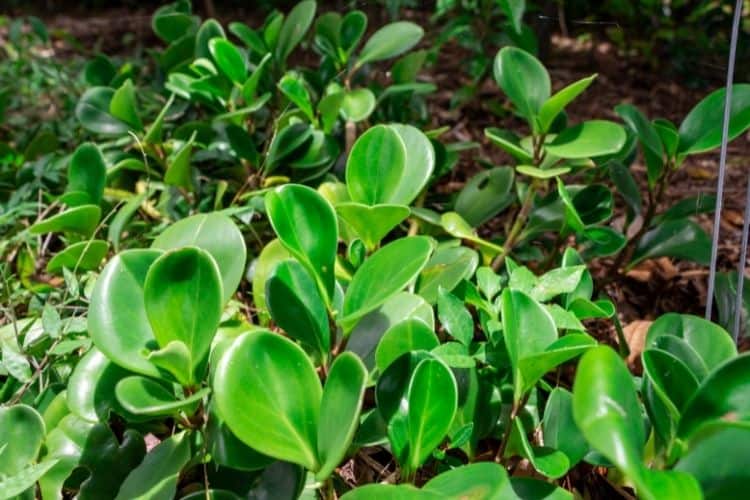
The baby rubber plant, or Peperomia obtusifolia, has slightly concave and glossy leaves, with some cultivars having cream, ivory, dark green, yellow, and white colorations.
It has thick and erect stems, and the plant can get up to 12 inches (30 centimeters) in height. It has greenish-white blooms that grow on spikes that are five inches (13 centimeters) long. This particular peperomia is winter hardy and can thrive in USDA zones 10 to 12.
Best for: Bright rooms can get lots of indirect light to help these plants maintain their vibrant colors.
Columnar Peperomia
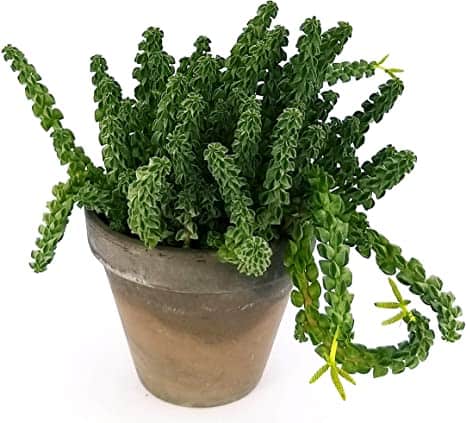
Peperomia columella, commonly known as the columnar peperomia, has fleshy stems that grow up to eight inches (20 centimeters) in height. They can spread up to 0.4 inches (one centimeter) wide. The leaves are arranged in an alternating pattern on these stems. This peperomia has an epidermal window at the tips of its leaves, and these can store water.
When springs, the columnar peperomia can produce tail-like blooms. These plants are hardy in USDA zones 10a to 11b.
Best for: Companion plantings with succulents and for those who like low maintenance plants
Metallic Peperomia
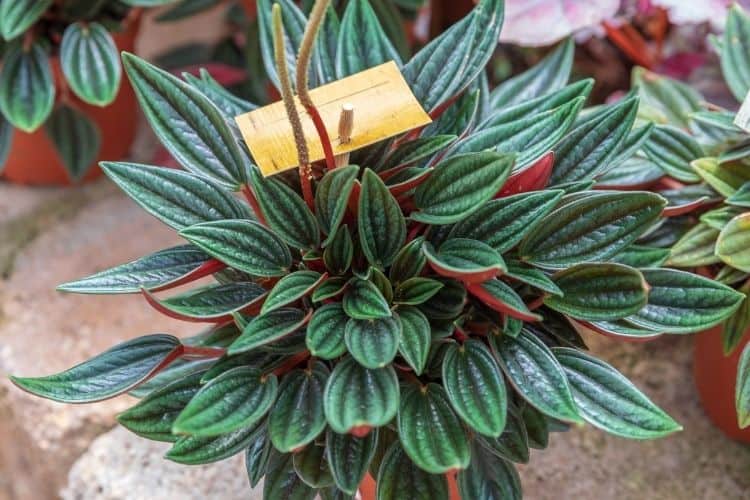
Defined by their pointy leaves, the metallic peperomia (Peperomia Rosso) has dark green leaves with a bit of silvery green coloration. The underside of these leaves, however, is deep red. The plant produces flower spikes that contain both male and female flowers. They bloom when the days are shorter than 12 hours. They thrive in USDA hardiness zones 10a to 11b.
Best for: Homes with low light conditions.
Peperomia Jelly
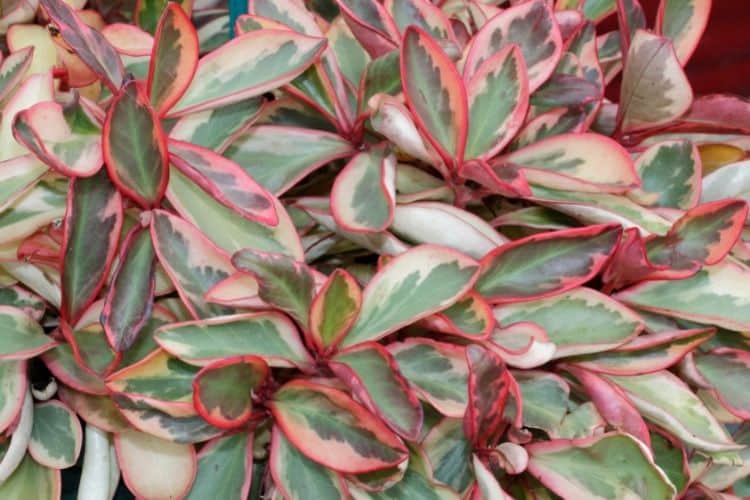
The peperomia jelly, or Peperomia clusiifolia, has larger leaves than most peperomias. These curled leaves have a dark green, white, yellow, cream, and light green variegation, and then the edges are red. The peperomia jelly thrives in USDA zones 10 to 12 and can reach six inches (15 centimeters) when it matures. It will have long vines that can trail up to 10 feet (3 meters).
If you give it the right care, the peperomia jelly will reward you with clusters of white flowers.
Best for: People who like flashy, colorful, and bright leaves.
Raindrop Peperomia
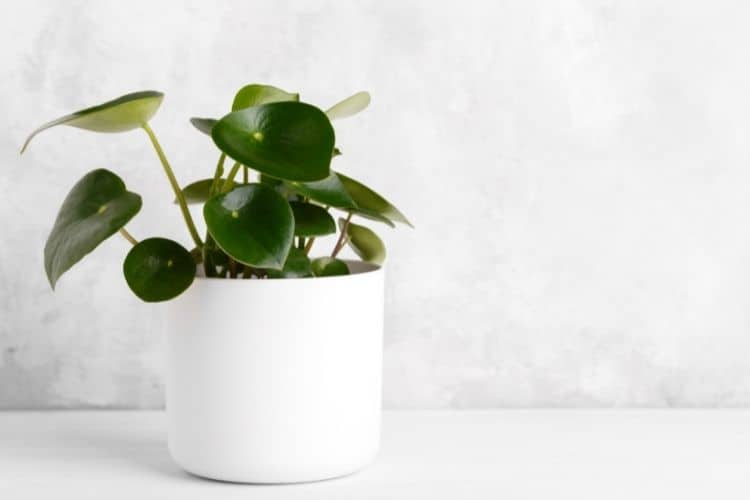
The raindrop peperomia, or Peperomia polybotrya, has emerald-colored leaves with a glossy shine. The rounded leaves taper off to a point, making it look like a drop of rain.
The plant is also known as the Jayde peperomia, coin plant, and sometimes mistakenly, the Chinese money plant. Indoors, these plants can survive in USDA zones 10 to 12, but if you’re growing it outdoors, it does well in USDA zone 10.
One of the things that differentiate this peperomia from the others is their flowers. These blooms can look like mouse tails that have green tips. The flowers grow on top of the stems, and they have a sweet smell that can fill the room. But these flowers do not last for a long time.
Best for: Bright rooms so that you can enjoy its deep and rich green leaves. It sometimes flowers when exposed to natural sunlight. The flower spikes are white, giving a nice contrast to the green foliage.
Red Ripple Peperomia
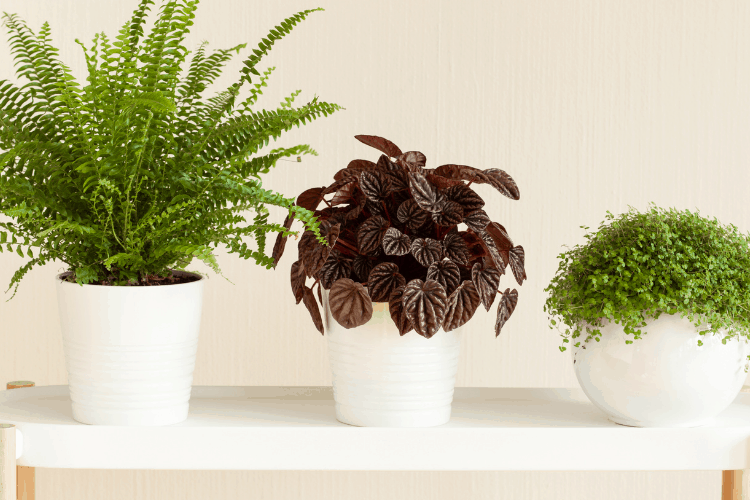
We have mentioned that most of the varieties have green, dark green, light green, white, yellow, or creme coloration. If you prefer to add a splash of color to your peperomia collection, then get the red ripple.
Known as the Peperomia caperata ‘Ripple Red’, this variety has red and deep purple-colored leaves. These leaves look interesting with their many ripples. This variety is epiphytic, and it forms a mound that is eight inches (20 centimeters) tall. There are other colors for ripple peperomia, not just red. These include silver, green, and emerald.
Best for: Darker rooms as they dark-colored leaves don’t need too many bright lights.
String of Turtles Peperomia
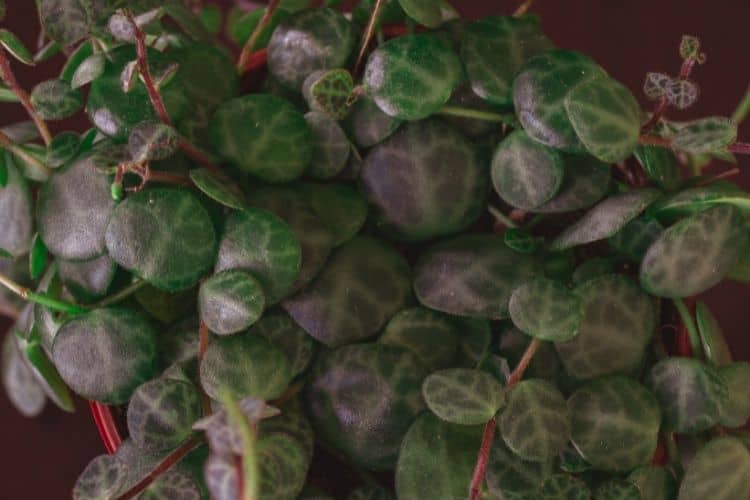
As you may have guessed, the string of turtles peperomia gets its name from leaves that look like a turtle’s shell. The tiny and round leaves on a Peperomia prostrata adorn the vines that can hang from containers on shelves or hanging baskets.
The unique shape and patterns will make an interesting addition to your home. It can grow up to 12 inches, and these plants are best suited to USDA zones 10 to 12.
Best for: Hanging baskets or pots that you can place on higher shelves to allow the vines to cascade down.
Trailing Jade

A trailing jade, or Peperomia rotundifolia, has round and tiny leaves that look like they came from succulents. This epiphyte can grow stems of up to 12 inches (30 centimeters) in length, where the round leaves can get rowdy and weave into each other.
This plant produces flower spikes with tiny blooms on it. Trailing jade can thrive in USDA zones 10a to 11b.
Best for: Darker rooms where you can give it a lot of humidity. The temperature should not change drastically. Great for hanging baskets that you can put overhead because of its trailing growth habit.
Peperomia Hope
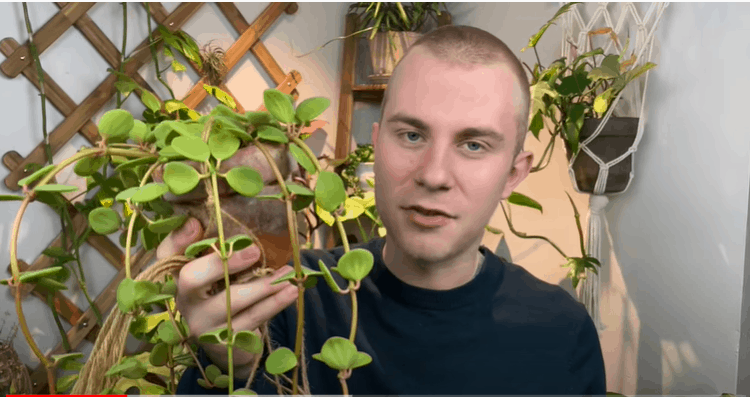
A Peperomia tetraphylla ‘Hope’ is commonly called the four-leaved peperomia or peperomia hope. This one looks like the trailing jade peperomia but with oval leaves and trailing stems. The leaves are also bunched together, and you can find them grouped into three or four leaves. This green peperomia can grow up to eight to 12 inches (20 to 30 centimeters) in height.
Best for: Hanging baskets where their veins can trail down.
Watermelon Peperomia
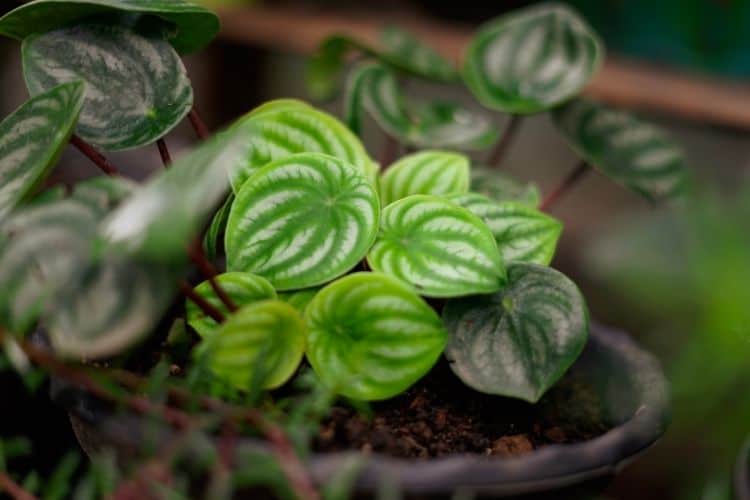
The Peperomia argyreia is commonly known as the watermelon peperomia. Its rounded leaves with a slightly pointed end have dark green and silvery green colorations, making it look like a watermelon. The herbaceous perennial may look nearly stemless and grows in rosettes. They can get up to six to eight inches in height when grown indoors.
The leaves can be up to 3.5 inches (8.9 centimeters) in length. The plant can have greenish flowers that grow on spikes that can reach up to three inches (7.6 centimeters) long.
Best for: Small spaces where you need a splash of whimsy and color.
Read More:
Caring for Your Peperomia
You will be happy to know that a majority of peperomias have similar care requirements.
Soil
Use a well-draining potting mix. Our recommendation is to get something acidic and chunky. You might want to try orchid potting medium such as:
- Rio Hamza Trading Orchid Potting Mix
- Repot Me Phalaenopsis Dark Classic Orchid Mix
- Perfect Plants All Natural Orchid Potting Mix
However, you can get away with using your ordinary garden soil. Just make sure to amend it with perlite or peat moss to make it better draining.
Watering
Peperomias have succulent leaves that can store water. You can do away with frequent watering, and these plants will still thrive.
If you’re not sure whether to water or not, it’s better to let your peperomia plants dry out a little. Overwatering them can lead to root rot.
Humidity and Temperature
Peperomia is native to tropical areas, so they like it when it’s warm and humid. Don’t put these plants anywhere with temperatures below 30 degrees Fahrenheit (-1.1 degrees Celsius).
These plants actively grow over the summer and would appreciate being outside during this time. If you keep them indoors, you might want to buy a humidifier such as the O-Mei Stars Small Humidifier to give them the optimum conditions for growth.
Alternatively, you can put pebbles into a bowl of water to raise the humidity levels in the room.
Light
Your peperomia will love medium to bright light. Giving them sufficient indirect sunlight will ensure that their leaves do not lose their vibrant colors.
You can put them near a bright window, but you should ensure that it’s not under direct sunlight. Putting it under the heat of the sun can scorch its leaves.
Black Spots on the Leaves
If your peperomia have black spots on the leaves, then that’s a sign that it’s getting too much direct sunlight. If this happens, you should first move the plant to a place where it has filtered, bright, and indirect light. If that’s not feasible, you can just put up a sheer curtain to help give it shade. Black spots, however, can be a signal that your plant is diseased.
Feeding Your Peperomia
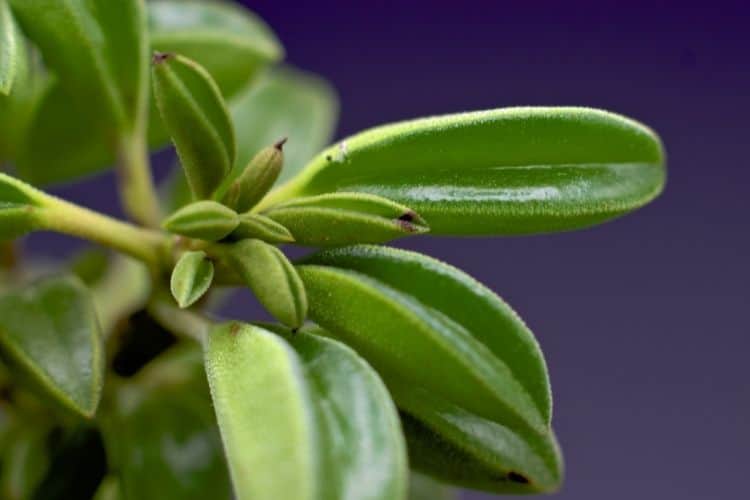
Peperomia plants are not voracious eaters. These slow-growing plants are more affected by too frequent watering or insufficient light than the lack of nutrients.
As such, you might not even need to fertilize your peperomia. Just make sure to give it a fresh batch of potting mix to get the nutrients it needs to survive.
Repotting Peperomia
Peperomia likes to be root bound, so you really don’t have to repot your plants for a long time. What’s more, these plants are slow-growing.
The only reason why you should transplant your peperomia is when you see their roots coming out of the drainage hole. When that happens, you should choose a pot that’s just a bit bigger than your current one and then use orchid bark or a potting mix that’s acidic and well-draining.
As it is, you can grow your peperomia in:
- Hanging baskets such as this La Jolie Hanging Planter
- Pots, such as this Elly DÉCOR Ceramic Planters
- Dish gardens such as this Wowser Large White Round Flower Pot Planter Dish
Different Groups Have Different Care Requirements
Because there are many types of peperomia plants out there, it’s not surprising that there are varieties that have slightly different needs.
For instance, epiphytic varieties might have small roots, so it’s dangerous to overwater them. This group of peperomia plants might also like higher humidity levels, but they can tolerate lower humidity.
Peperomia varieties that sport two-toned leaves will have darker colors for the undersides of their leaves. The darker coloration helps the plant to conserve light and can easily thrive in low-light conditions. These plants might lose their variegation if you put them under bright light.
Tuberous peperomia plants like high humidity and moist soil. There are also varieties of peperomias that come from higher elevations, and this group needs stronger and brighter light.
If your plant has folded or fat leaves, you might need to put them in a location to get bright light for most of the day and have a few hours of mild direct sunlight.
Collect Peperomia Plants Today
With the wide range of shapes, forms, growing habits, and colors, you can have a peperomia collection where no two plants look alike.
Plus, these plants are relatively low maintenance. Just provide the right kind of soil, put them where they can get all the light they need, and give them the right levels of humidity, and you’re set to go.
Most of these plants are not prone to insects, pests, and diseases. You don’t even have to fertilize them or repot them as frequently as other plants.
FAQs
Question: How do You Propagate Peperomia Plants?
Answer: The fastest way to propagate your peperomia is by getting cuttings. Cut an inch of a stem with a leaf on it and put it in a small container with potting soil.
• Insert the cut part into the soil and then cover the entire pot with plastic wrap. Doing this will keep the moisture in.
• Be sure to water the cutting consistently and be careful that the soil never dries out. Roots will emerge in a few weeks.
• Once you see the roots, transplant your peperomia into a bigger pot.
Question: Are Peperomias Susceptible to Pests?
Answer: Among the biggest problems you have with peperomia plants is root rot. If the soil is always moist, these plants will develop root rot or stem rot. It’s also very prone to getting attacked by mealybugs, whitefly, and spider mites. Use insecticidal soap to get rid of these insects.
Question: Where Can You Buy Peperomias?
Answer: Your local garden center will have several varieties of peperomia plants that you can buy. You can also find some at Lowes or Home Depot. Online, you can get the peperomia variety that you want from such retailers as:
• Amazon
• Etsy
• Garden Goods Direct
• Planterina
• Steve’s Leaves
• Taylor Greenhouses
Question: What Does Peperomia Mean Anyway?
Answer: The genus name comes from a pair of Greek words:
• Peperi means pepper
• Homoios means looks like or resembling
So peperomia just means that these plants look like black pepper. They even belong to the same Piperaceae family.
Research Citations
- DIYs.com Peperomia Clusiifolia Care: How to Grow & Care For The Jelly Plant.
- Gardening Chores: How To Plan, Grow And Care For Peperomia Indoors
- Houseplant Resource Center: The Ultimate Guide to Peperomia Varieties
- Journal of Experimental Botany: The influence of epidermal windows on the light environment within the leaves of six succulents
- Missouri Botanical Garden: Peperomia Argyreia
- Missouri Botanical Garden: Peperomia Obtusifolia
- Peperomia.net: How many Peperomias?
- Plant Care Today: How To Care For Peperomia Hope
- Plant Care Today: Peperomia Polybotrya Care: Coin-Leaf | Peperomia Raindrop
- The Spruce: How to Grow Peperomia Plants Indoors
- The Spruce: How to Grow String of Turtles
- University of Vermont Extension Department of Plant and Soil Science: CARE OF PEPEROMIAS
- World of Succulents: Peperomia Rosso
- World of Succulents: Peperomia rotundifolia (Round Leaf Peperomia)
